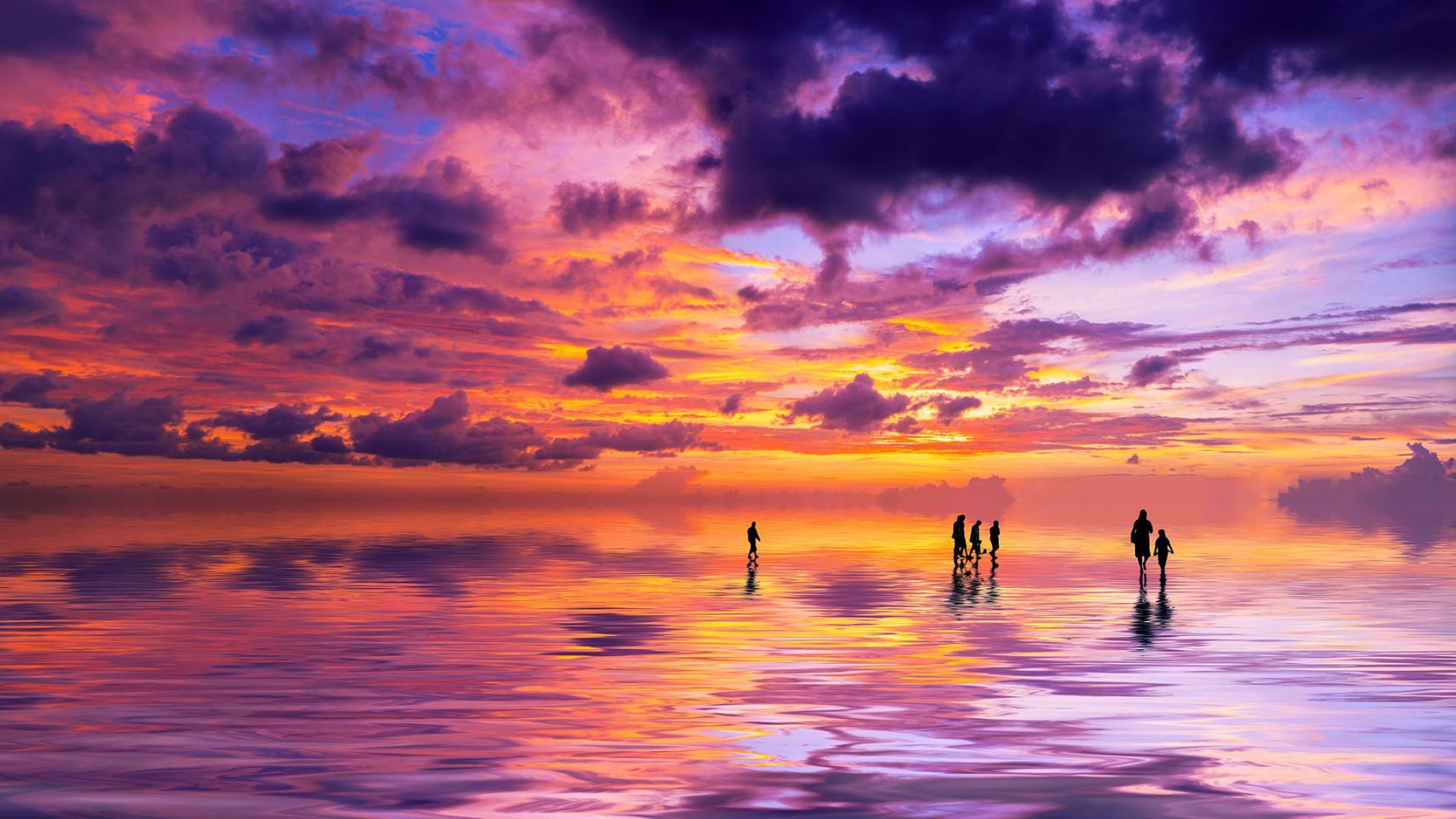Home>Travel and Places>The Most Breathtaking Sunset You’ll Ever Witness


Travel and Places
The Most Breathtaking Sunset You’ll Ever Witness
Published: February 10, 2024
Experience the most breathtaking sunset of your life with our travel guide. Discover the best places to witness stunning sunsets around the world.
(Many of the links in this article redirect to a specific reviewed product. Your purchase of these products through affiliate links helps to generate commission for Regretless.com, at no extra cost. Learn more)
Table of Contents
Introduction
When was the last time you paused to witness the breathtaking beauty of a sunset? Picture this: the sky ablaze with a mesmerizing palette of warm hues, the sun gradually descending behind the horizon, casting a golden glow that gently fades into the deepening twilight. It's a spectacle that never fails to evoke a sense of wonder and tranquility, a celestial masterpiece that leaves an indelible impression on those fortunate enough to behold it.
Sunsets have long captivated the human imagination, inspiring artists, poets, and dreamers across the ages. They symbolize the fleeting nature of time and the promise of a new beginning as the day transitions into night. Each sunset is a unique and ephemeral work of art, a vivid reminder of the awe-inspiring forces at play in the natural world.
In this article, we'll embark on a journey to explore the magic of sunsets, delving into the science behind these awe-inspiring displays and uncovering the factors that contribute to their stunning beauty. We'll also uncover some of the world's most enchanting locations to witness the perfect sunset and provide photography tips to help you capture the moment and preserve its splendor forever.
So, join us as we dive into the enchanting realm of sunsets, where time stands still, and the sky transforms into a canvas of unparalleled beauty. It's time to embark on a captivating journey that celebrates the magnificence of nature's grand finale—the most breathtaking sunset you'll ever witness.
Understanding Sunsets
Sunsets are a natural phenomenon that never fails to captivate and inspire. But what exactly causes this awe-inspiring spectacle? At its core, a sunset is the result of the Earth's rotation and its position in relation to the sun. As the Earth orbits the sun, its axial tilt causes different parts of the planet to experience varying lengths of daylight.
During a sunset, the sun appears to sink below the horizon as the Earth continues its rotation. This creates the illusion of the sun's descent, accompanied by the gradual transformation of the sky's colors. The scattering of sunlight by the Earth's atmosphere is central to the vivid hues that paint the evening sky.
The Earth's atmosphere acts as a prism, dispersing the sun's light into its component colors. When the sun is higher in the sky, its light passes through a smaller portion of the atmosphere, resulting in the familiar blue hues of daytime. However, as the sun sets, its light must traverse a greater distance through the atmosphere, causing shorter wavelengths (such as blue and green) to scatter, while longer wavelengths (such as red and orange) remain prominent. This scattering effect is what imbues sunsets with their characteristic warm and vibrant tones.
Furthermore, the presence of airborne particles, such as dust, pollutants, and water droplets, can enhance the scattering effect, intensifying the kaleidoscope of colors that adorn the twilight sky. The interplay of these atmospheric elements, combined with the angle of the sun's rays, contributes to the unique and ever-changing spectacle of each sunset.
In essence, understanding sunsets involves appreciating the harmonious interplay of celestial mechanics, atmospheric physics, and the Earth's natural elements. It's a reminder of the intricate dance between light, color, and the forces of nature, culminating in a breathtaking display that never fails to stir the soul.
Factors Affecting Sunset Beauty
The beauty of a sunset is a result of a harmonious interplay of various factors that converge to create a mesmerizing visual symphony. Understanding these elements provides insight into why some sunsets are simply breathtaking, while others may be more subdued.
-
Atmospheric Conditions:
The composition and density of the Earth's atmosphere significantly influence the appearance of a sunset. When the atmosphere contains a higher concentration of airborne particles, such as dust, pollutants, or water droplets, the scattering of sunlight is intensified. This amplifies the dispersion of shorter wavelengths, allowing the warm, vibrant colors of the sunset to dominate the sky. In contrast, a clear, pristine atmosphere may produce a more subtle, pastel-hued sunset. -
Weather Patterns:
The presence of clouds can dramatically enhance the visual impact of a sunset. Wispy cirrus clouds often catch the last rays of the sun, igniting the sky with fiery hues and adding depth and texture to the scene. Conversely, a completely overcast sky may obscure the sun, resulting in a less striking display. The interplay of cloud formations and the position of the sun can create a dynamic and ever-changing canvas of colors. -
Geographical Location:
The topography and geographical features of a location can influence the panoramic spectacle of a sunset. Coastal regions offer unobstructed vistas, allowing the sun to sink majestically into the horizon, casting shimmering reflections across the water. Mountainous terrain may provide elevated vantage points, offering panoramic views and the opportunity to witness the sun setting behind a rugged silhouette. Urban landscapes, with their towering structures, can create a dramatic juxtaposition of man-made and natural beauty during sunset. -
Time of Year:
The changing seasons impart unique qualities to sunsets. In certain latitudes, the angle at which the sun sets varies throughout the year, leading to a shifting canvas of colors and intensities. During certain seasons, the Earth's axial tilt may align the sun with specific geographical features, accentuating the visual drama of the sunset. -
Human Influence:
Human activities can also impact the beauty of a sunset. Air pollution, industrial emissions, and urban development can alter atmospheric conditions, potentially affecting the clarity and vibrancy of the setting sun. Conversely, conservation efforts and sustainable practices can contribute to preserving the natural elements that enhance sunset beauty.
In essence, the allure of a sunset is a product of the delicate interplay between natural and atmospheric elements, geographical features, and the dynamic forces of nature. Each sunset is a fleeting masterpiece, shaped by the convergence of these factors, offering a unique and unforgettable experience for those fortunate enough to witness its splendor.
The Perfect Sunset Viewing Spots
As the day draws to a close, and the sun begins its majestic descent, there are certain locations around the world that offer an unparalleled vantage point to witness the perfect sunset. These destinations are renowned for their awe-inspiring natural beauty, unique geographical features, and captivating vistas that elevate the sunset-watching experience to new heights. Whether perched atop a rugged cliff, nestled on a pristine beach, or gazing across a sprawling urban skyline, these perfect sunset viewing spots promise to deliver moments of pure enchantment.
1. Santorini, Greece
Santorini, with its iconic whitewashed buildings and azure-domed churches, is renowned for its mesmerizing sunsets. The island's western coastline offers unobstructed views of the sun as it dips below the horizon, casting a warm, golden glow across the caldera and the Aegean Sea. The dramatic cliffs and cascading terraces create a stunning backdrop, setting the stage for a sunset spectacle that is nothing short of extraordinary.
2. Grand Canyon, Arizona, USA
The Grand Canyon, with its vast expanse of rugged terrain and awe-inspiring geological formations, provides a breathtaking setting for sunset viewing. As the sun descends, the canyon is bathed in a kaleidoscope of colors, illuminating the ancient rock formations and painting the sky with vibrant hues. The interplay of light and shadow creates a visual symphony that is as humbling as it is captivating.
3. Uluru-Kata Tjuta National Park, Australia
In the heart of the Australian Outback, the sacred red rock formations of Uluru and Kata Tjuta serve as a mesmerizing backdrop for sunset enthusiasts. As the sun sets over the vast desert landscape, the sandstone monoliths undergo a stunning transformation, radiating intense reds and oranges that seem to ignite the horizon. The spiritual significance of this land adds a profound dimension to the sunset experience, making it a truly transcendent spectacle.
4. Mauna Kea, Hawaii, USA
Perched atop the summit of Mauna Kea, the highest peak in Hawaii, sunset gazers are treated to a celestial performance unlike any other. The panoramic views from this vantage point encompass the Pacific Ocean, distant volcanic peaks, and the celestial dome above. As the sun dips below the horizon, the sky is set ablaze with a breathtaking display of colors, creating an ethereal ambiance that lingers long after the last rays have faded.
5. Serengeti National Park, Tanzania
In the vast expanse of the Serengeti, where the African savannah stretches to the horizon, the sunset takes on a mesmerizing quality. Against the backdrop of acacia trees and endless plains, the sun casts a warm, golden glow, painting the landscape in hues of amber and gold. The silhouettes of wildlife against the setting sun add a touch of untamed beauty to this extraordinary natural spectacle.
These perfect sunset viewing spots are not merely locations to witness the sun's daily retreat; they are immersive experiences that evoke a sense of wonder, awe, and profound appreciation for the natural world. Each destination offers a unique tapestry of sights, sounds, and emotions, ensuring that every sunset is a timeless and unforgettable encounter with nature's grand finale.
Capturing the Moment: Photography Tips
Capturing the ephemeral beauty of a sunset through photography is a rewarding endeavor that allows enthusiasts to preserve and share the magic of these fleeting moments. Whether you're an amateur photographer or a seasoned professional, here are some valuable tips to help you capture the essence of a breathtaking sunset:
-
Timing is Everything: Arrive at your chosen location well in advance of the anticipated sunset. This allows you to scout the area, set up your equipment, and prepare for the optimal shooting conditions as the golden hour approaches.
-
Scout for Unique Perspectives: Explore the surroundings to find compelling elements that can enhance your sunset photographs. Consider incorporating natural features, such as silhouetted trees, reflective bodies of water, or architectural elements, to add depth and interest to your compositions.
-
Use a Tripod: Stability is crucial for capturing sharp and well-composed sunset images. A sturdy tripod helps minimize camera shake, allowing you to experiment with longer exposures and maintain clarity in low-light conditions.
-
Experiment with Exposure: Embrace the dynamic range of a sunset by adjusting your camera's exposure settings. Consider bracketing your shots to capture a range of exposures, from the vivid hues of the sky to the subtle details in the landscape.
-
Focus on the Horizon: When framing your sunset shots, pay attention to the placement of the horizon. Experiment with different compositions, such as placing the horizon along the lower or upper third of the frame, to create visually engaging images.
-
Utilize Filters: Consider using graduated neutral density filters to balance the exposure between the bright sky and the darker foreground, ensuring that both elements are properly exposed without sacrificing detail.
-
Capture Silhouettes: Embrace the enchanting silhouettes that emerge during sunset. Experiment with positioning subjects in front of the setting sun to create striking and evocative silhouettes against the colorful backdrop.
-
Stay Beyond Sunset: The moments following sunset, known as the blue hour, offer a unique opportunity to capture the transition from dusk to night. The soft, diffused light during this period can yield captivating images with a serene and ethereal quality.
-
Post-Processing Magic: After capturing your sunset images, leverage post-processing tools to enhance and refine your photographs. Adjusting the white balance, fine-tuning exposure, and accentuating the vibrant colors can elevate the visual impact of your sunset shots.
By applying these photography tips, you can elevate your sunset photography game and immortalize the captivating beauty of dusk in stunning visual narratives. Remember, each sunset is a fleeting masterpiece, and through photography, you have the power to encapsulate its splendor for generations to come.
The Emotional Impact of Sunsets
As the sun gracefully descends, painting the sky with a symphony of warm hues, it invokes a profound emotional impact that transcends mere visual beauty. The fleeting moments of a sunset have the power to evoke a myriad of emotions, stirring the soul and leaving an indelible impression on the human spirit.
First and foremost, sunsets have a remarkable ability to instill a sense of tranquility and serenity. As the day draws to a close, the gentle transition from daylight to twilight creates a peaceful ambiance that invites introspection and contemplation. The serene beauty of a sunset offers a respite from the hustle and bustle of daily life, allowing individuals to pause, reflect, and find solace in the ephemeral splendor unfolding before them.
Moreover, sunsets have a profound capacity to inspire awe and wonder. The breathtaking display of vibrant colors, the interplay of light and shadow, and the dramatic transformation of the sky ignite a sense of amazement and reverence for the natural world. Witnessing a sunset can awaken a deep appreciation for the beauty and grandeur of the universe, reminding us of our place within the cosmic tapestry.
In addition to tranquility and awe, sunsets often evoke a profound sense of nostalgia and introspection. The fleeting nature of a sunset serves as a poignant reminder of the passage of time and the impermanence of life. It prompts individuals to cherish the present moment, reflect on cherished memories, and contemplate the possibilities that lie ahead. The bittersweet beauty of a sunset encapsulates the essence of nostalgia, inviting introspection and a deep emotional connection to the ephemeral nature of existence.
Furthermore, the emotional impact of sunsets extends to the realm of inspiration and creativity. Artists, writers, and dreamers have long drawn inspiration from the evocative beauty of sunsets, harnessing its emotional resonance to create works of art that capture the essence of human experience. The vivid colors, the interplay of light and dark, and the profound emotional depth of a sunset have fueled the creative spirit throughout history, serving as a wellspring of artistic expression and emotional storytelling.
In essence, the emotional impact of sunsets is a testament to the profound influence of nature on the human experience. Whether evoking tranquility, inspiring awe, stirring nostalgia, or fueling creativity, sunsets hold a timeless allure that transcends cultural and geographical boundaries. Each sunset is a fleeting masterpiece that resonates with the deepest recesses of the human heart, leaving an emotional imprint that lingers long after the last rays of light have faded.
Conclusion
In the grand theater of nature, few spectacles rival the captivating allure of a sunset. As the sun bids farewell to the day, it paints the sky with a mesmerizing display of colors, casting a spell that transcends the boundaries of time and space. The journey to understand and appreciate the magic of sunsets has taken us on a captivating exploration of celestial mechanics, atmospheric alchemy, and the emotional resonance of nature's grand finale.
Sunsets are not merely astronomical events; they are profound expressions of the interconnectedness between the Earth, the sun, and the elements that shape our world. The interplay of light, color, and atmospheric dynamics creates an ever-changing canvas of beauty, offering a timeless reminder of the ephemeral nature of existence.
From the tranquil shores of Santorini to the rugged grandeur of the Grand Canyon, the world is adorned with perfect sunset viewing spots that invite us to bear witness to the celestial drama unfolding each evening. These locations, each with its own unique tapestry of sights and emotions, serve as portals to moments of pure enchantment, where time seems to stand still, and the world is bathed in the golden glow of twilight.
The art of capturing the essence of a sunset through photography is a testament to the enduring allure of these fleeting moments. With each click of the shutter, enthusiasts immortalize the beauty of dusk, preserving its splendor for generations to come. The tips and techniques shared in this article serve as a guide to elevate the craft of sunset photography, empowering individuals to encapsulate the emotional depth and visual splendor of these celestial performances.
Finally, the emotional impact of sunsets transcends mere visual beauty, stirring the soul and inviting contemplation. From the tranquility and awe they inspire to the nostalgia and creativity they evoke, sunsets weave a tapestry of emotions that resonate deeply within the human spirit. They serve as poignant reminders of the beauty and impermanence of life, inviting us to cherish the present, reflect on the past, and embrace the limitless possibilities of the future.
In conclusion, the most breathtaking sunset you'll ever witness is not merely a celestial event; it is a symphony of light, color, and emotion that unfolds each evening, inviting us to pause, marvel, and find solace in the wondrous beauty of the natural world.













